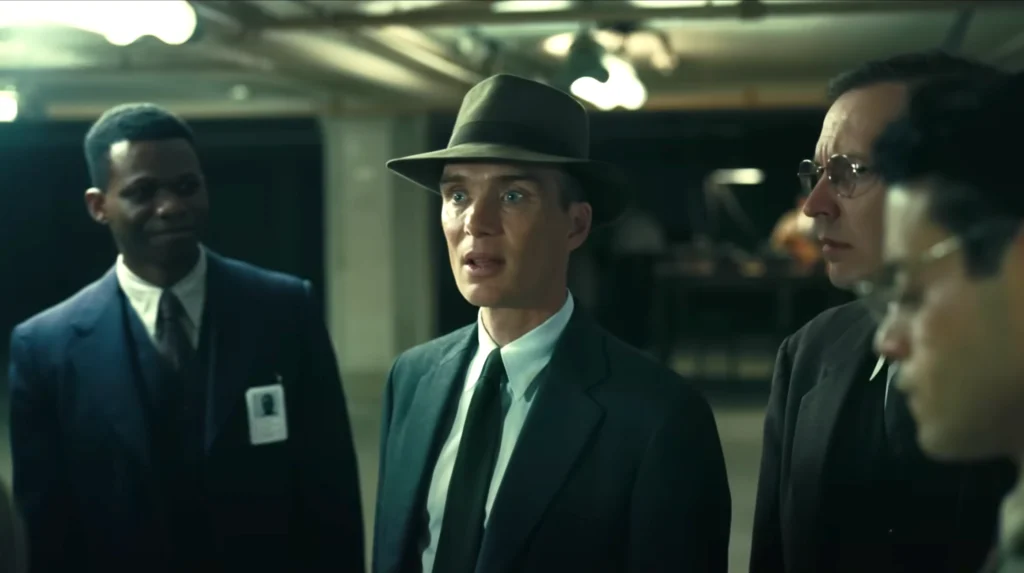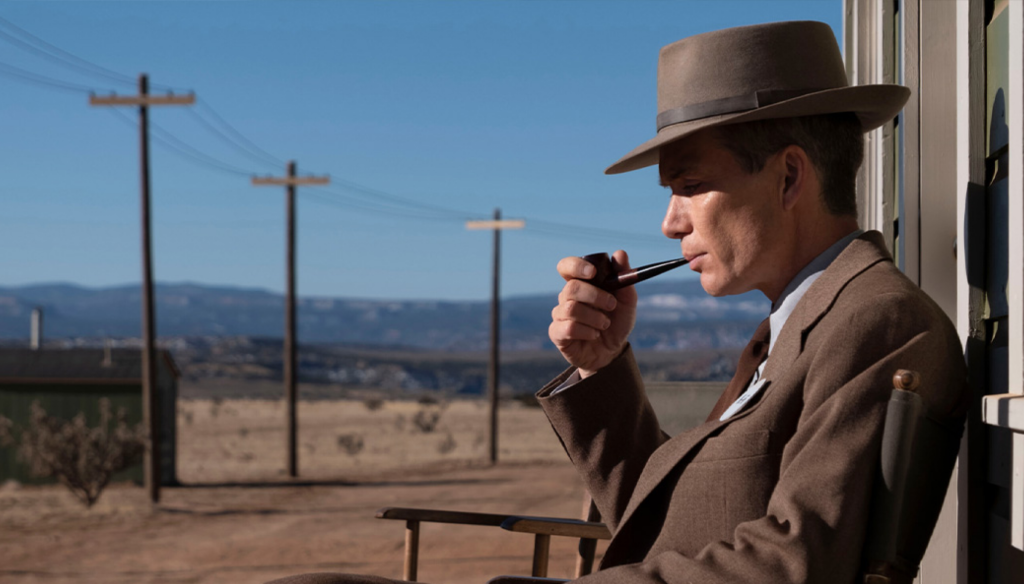Movie Review: Oppenheimer
Just because science can, does that mean it should? That’s the question plaguing the world today as we contemplate the long-term ramifications of things like genetic modification and AI, and it is certainly at the heart of Christopher Nolan’s explosive (pun completely intended) Oppenheimer, an absolutely jaw-dropping cinematic achievement about the creation and deployment of the atomic bomb.
Oppenheimer works on numerous levels. It’s a character study of the brilliant and obsessive J. Robert Oppenheimer (Cillian Murphy)—Oppy, as he’s known to friends—a man whose ego ultimately got in the way of his principles. It’s a philosophical contemplation of how the thirst for knowledge and the pursuit of power can intersect in catastrophic ways. And it’s a riveting procedural about the creation of the atomic bomb and its aftermath.
Yes, the film is three hours long, but it zips by, thanks to some wizardry by Nolan. Never has a film filled with so many men in suits and military uniforms discussing things felt so riveting. He’s aided by agile editing, glittering performances by a star-studded cast, his own ingenious and multilayered screenplay, and one of the year’s soundtracks by Ludwig Göransson designed to rattle you to your core. Fair warning: Oppenheimer is extremely loud.
There are stomping feet and bone-quaking explosions, and a cacophony of twitchy, anxiety-inducing strings. You are meant to feel unsettled—and it works. The film presents several timelines at once. Among those, we see Oppenheimer as a student at Cambridge, where visions of exploding cosmos and infinite doom haunt him. We see him as a professor at UC Berkeley, where he is the first man to bring quantum physics to the U.S. We see him at Los Alamos, where he builds the bomb.

And we see him in a closed-door hearing, where he’s in danger of losing his security clearance. When Oppenheimer first arrives at Berkeley, he has but one student, but eventually, word gets out that he’s not only an excellent teacher—charismatic and challenging and provocative—but he’s doing something truly groundbreaking in that class. Soon, he’s surrounded by a coterie of adoring young scientists who are less students than groupies. At that time, he begins to be interested in communism—the film makes it clear that most left-leaning intellectuals were at least dabbling in communism in the ’40s.
He attended meetings but never officially joined the party, although his beloved younger brother (Dylan Arnold) was a member. This communist-curious period of his life would have long-term ramifications for the scientist. It’s also at these communist meetings where he met both Jean Tatlock (Florence Pugh), the troubled and withholding woman who was the great love of his life and Kitty (Emily Blunt), the smart and fiercely loyal biologist he would go on to marry and have children with.
Oppenheimer, the film, is positively filled with men—politicians, scientists, academics and even Albert Einstein (a sly Tom Conti). There was a joke online that if you were a white man who hadn’t been cast in Oppenheimer, you needed a better agent. Often, I would say such a who’s who of a cast is a distraction. But in this case, it really adds to the fun. Who’s that playing Truman? Why yes, it’s Gary Oldman. Is that Rami Malek? I liked it because it really gave certain character actors—notably David Krumholtz, Benny Safdie, Kenneth Branagh, and Alden Ehrenreich—a chance to shine.
But two men in particular had an outsized influence on the shape and trajectory of Oppenheimer’s life. One was Lewis Strauss (Robert Downey
Jr., giving a performance that has all but guaranteed a Best Supporting Actor Oscar), who hired Oppenheimer to head up the astrophysics department at Princeton. Strauss is a great admirer of Oppenheimer’s and seems like an ally—at first.

The other man is Lieutenant General Leslie Groves (Matt Damon), who recruits Oppenheimer to run the Manhattan Project with the goal of creating a bomb so powerful that it will end the scourge of Naziism once and for all. He knows about Oppenheimer’s communist leanings in the past but believes that the scientist is a true patriot. Also, crucially, he needs Oppenheimer, which is the bottom line. Oppenheimer’s mistake, it seems, was assuming that Groves’ loyalty to him would extend beyond his usefulness.
From there, there’s a bit of a “let’s get the team together” montage as they build the secret laboratory in Los Alamos—a beloved site of Oppenheimer family vacations and also the perfect place to test bombs—and assemble some of the brightest scientific minds in the U.S. and beyond. The scientist Isidor Rabi (Krumholtz) expresses the most moral qualms. Yes, the only thing worse than the U.S. having such a bomb is the Nazis having such a bomb.
But anyone who creates an atomic bomb will have an incalculable amount of blood on their hands. But Oppenheimer proceeds. Partly because he’s really convinced himself a bomb like this could save lives—the ultimate way to scare a warring nation into laying down its arms—but also because he has to see it through. The need for discovery in him is insatiable.
The scene where they first detonate the actual atomic bomb at Los Alamos is filled with almost unbearable tension. And here, Nolan uses sound design to pull off his greatest trick. (You’ll have to see for yourself.) Suddenly, they have a working atomic bomb, and Oppenheimer is no longer needed. Groves essentially says, “We’ll take it from here, doctor”, and drives away. And they do take it from there, dropping the bomb not on Germany and the Nazis— Hitler is already dead—but on Hiroshima and Nagasaki. As Oppenheimer’s scientists cheer him on like a conquering hero, he’s overcome with a feeling of dread. He has visions of skin peeling off face and sees a blinding white light. And he’s not the only one who sees the horror of this “achievement.” Amid the cheering, one scientist throws up.
Another weeps. What have they wrought? After that, Oppenheimer becomes something of a pacifist, trying to halt the building of the even more powerful hydrogen bomb and advocating for peace talks with Russia. But it’s too late. The genie is out of the bottle. “This isn’t a new weapon,” says his mentor, Niels Bohr (Branagh). “It’s a new world.” And Oppenheimer is about to be ensnared by the Red Scare sweeping the country. Will he go from national hero to villain?
For all of Oppenheimer’s probing questions about man’s willingness to destroy itself, the question Nolan is perhaps most interested in is: Why did
Oppenheimer do what he did? Murphy’s performance is extraordinary. The actor shares Oppenheimer’s haunted, pale blue eyes and high, somewhat sunken cheekbones and craggy physique (he lost a lot of weight for the role), and he perfectly embodies the paradoxes of the physicist—brilliant in science but reckless in his personal life; outwardly cocky but plagued by doubt; relentlessly driven but unbearably tormented. Thanks to Nolan and Murphy, we see the full Oppenheimer—neither monster nor saviour, victim nor villain, but in the end, just a man.
Boluwatife Adesina is a media writer and the helmer of the Downtown Review page. He’s probably in a cinema near you.





